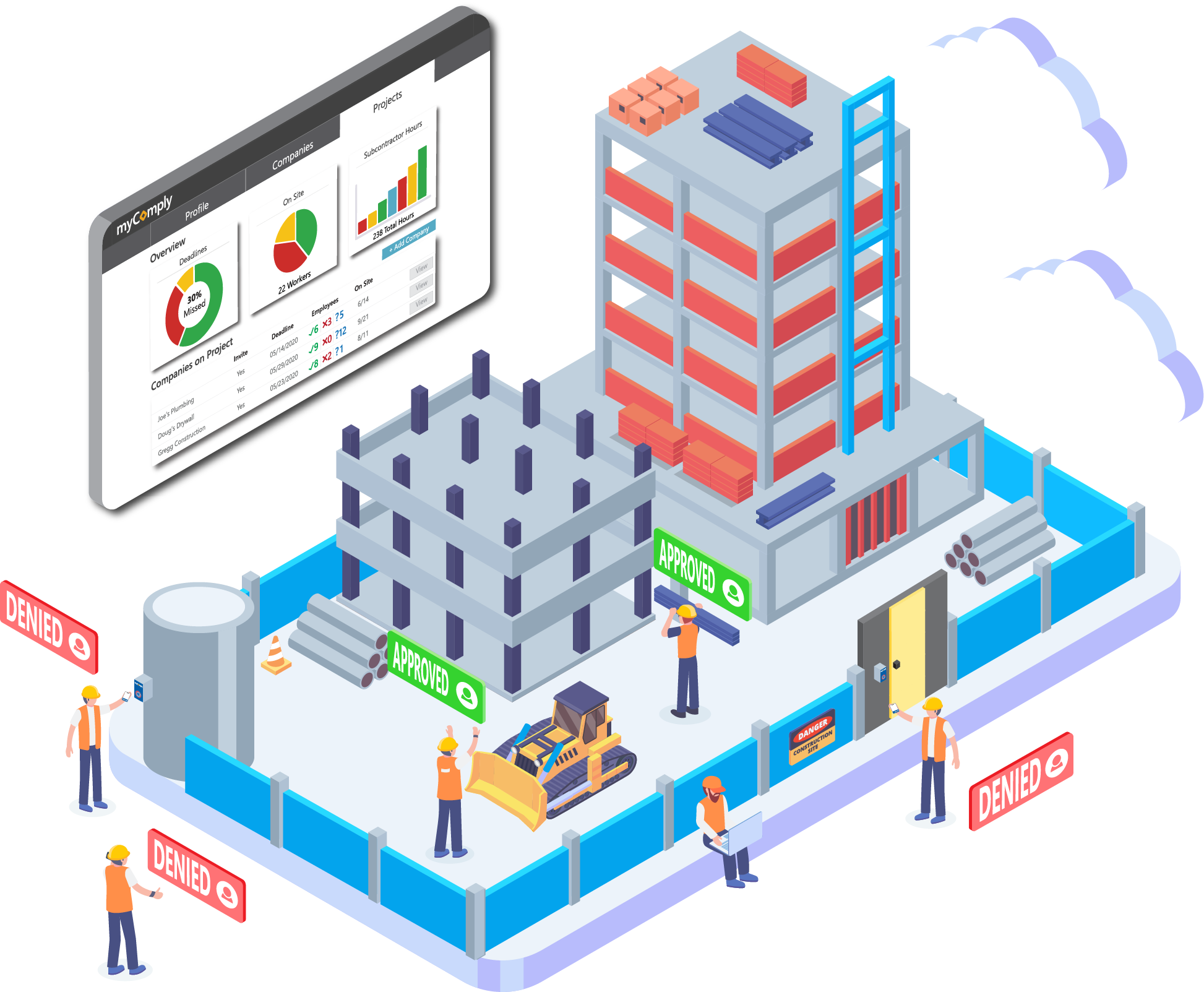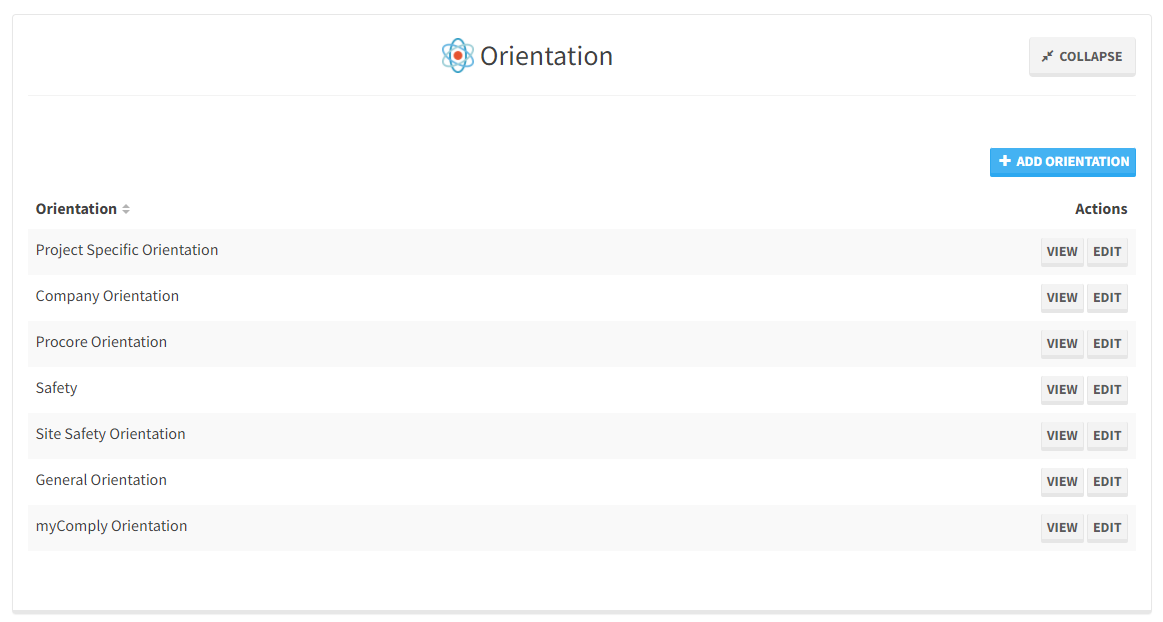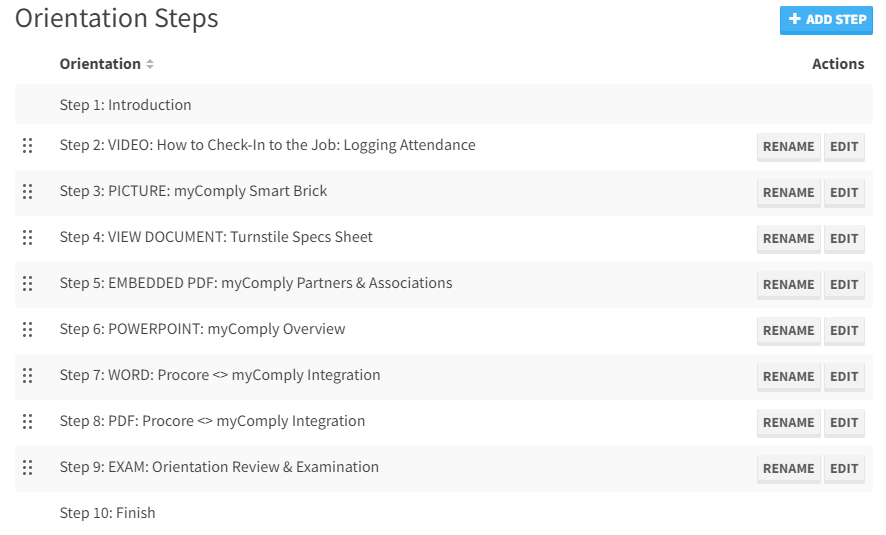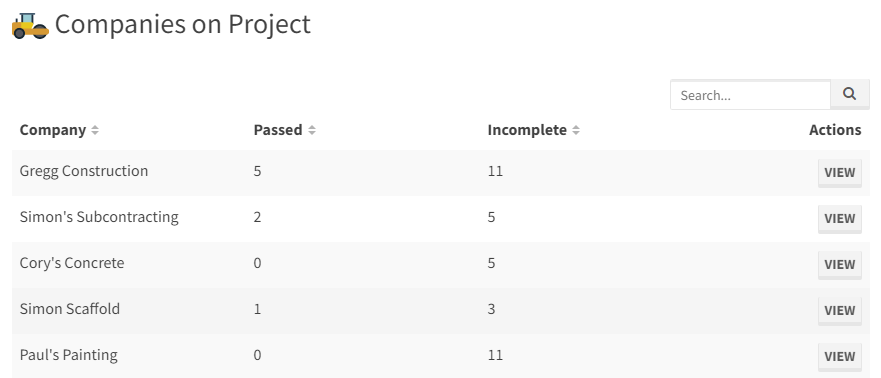A new contractor orientation ensures that all workers are prepared to work safely and efficiently on-site. This is especially important for workers unfamiliar with a project site, the general contractor, the environment, and/or unfamiliar with expectations of the project management team.
On any construction project, workers should go through a formal orientation as a critical component of the worker onboarding process. All contractors must participate in orientations, but contractors who are new to working together will especially benefit from clear expectation setting via the orientation process.
In this article, we look to outline the new contractor orientation process, the traditional means of conducting new contractor orientation, and technology that can help administer and track orientations for the entire workforce in an efficient manner.
Table of Contents
- Intro
- The Traditional New Contractor Orientation Process
- The Risk of One Worker Not Going Through a New Contractor Orientation
- What Topics, Content, or Themes Should a New Contractor Orientation Cover?
- The Advantages of Orientation Software & Online Orientation Administration
- The Most Effective Way to Administer a New Contractor Orientation
The Traditional New Contractor Orientation Process
The traditional way of doing things often means there is a particular process around how something is completed or executed, and it has been done this way for years. In many cases, this saying or statement might mean there is room for innovation and process improvements. Traditionally speaking, the construction industry has somewhat standardized the way that project teams conduct new contractor orientations. Let’s explore the process further.
The traditional new contractor orientation might look something like this for a worker arriving to site on their first day:
1) The worker arrives to site with little or no direction
2) Project staff (the general contractor) directs them to the site office trailer
3) The worker fills out various paperwork (name, work history, certifications, and other info)
4) The worker waits for sign-off from project staff (the general contractor)
5) The project manager, site manager, or site safety personnel verify paperwork
> If/when the information is verified, the worker then proceeds to orientation
6) The worker sits through orientation
7) The worker verifies learning, via quiz or acknowledgment of participation in orientation
8) The worker is approved, or is deemed not ready
> Worker may repeat exam or other processes if not yet considered fit to start work
Did you notice anything inefficient about the traditional process? Maybe, or maybe not.
The truth is that the traditional way of doing things often leads to a member of the site staff (usually a project manager or safety manager) having to do a lot of manual work to ensure that all workers are onboarded successfully. This puts a ton of responsibility on the project team to make sure that all workers have completed orientation, that nobody starts work without proper onboarding, and often it distracts these individuals from other tasks on their plates. There is an increased chance that the overburdened individual managing everything has something slip between the cracks.
So, what happens if something gets lost in the shuffle? We’ll explore how even ONE single worker without the proper onboarding and orientation can impact project success, project profitability, and increase the risk of injuries/accidents on-site.
The Risk of One Worker Not Going Through a New Contractor Orientation
What happens when the manual processes and traditional way of doing things leads to even ONE worker not going through the appropriate onboarding and orientation? Well, one worker without the appropriate orientation poses an enormous risk to the site and the insurance agreements that the General Contractor has likely already signed.
A worker who does not complete an orientation:
1) Is at an increased risk of injury, accident, or worse on the jobsite.
- A worker who has not received an orientation is unable to understand the importance or safety, the specific dangers on the site, and is ultimately in danger of an injury or accident.
- New workers pose 3 times as much risk for a lost time injury (Toronto Institute for Work & Health)
- In the first 4 weeks of a job, new workers are 5 to 7 times more likely to be at risk of injury. One of the leading causes being inadequate training and orientation (Safe Work Manitoba).
2) May violate the terms of your insurance arrangements.
- A general contractor’s insurance agreement might state that all workers have properly completed orientation to qualify for coverage.
- An uninsured worker getting into an accident on-site is extremely costly, with some accidents costing up to $1,220,000 (National Safety Council – Injury Facts).
3) May violate regulations and OSHA Act responsibilities.
- Under the OSHA Act, employers are responsible for providing a safe and healthful workplace.
- If a lack or absence of site orientation leads to an injury and an OSHA inquiry, single fines could be $13,653/violation and repeated negligence could lead to fines of $136,532/violation (United States Department of Labor – OSHA).
With the numbers laid out and the facts set straight, is it worth not having a comprehensive new contractor orientation plan? No.
All general contractors should have a detailed orientation process and plan to ensure that all workers have completed the necessary training and onboarding. You cannot afford to have even one worker enter a site and begin work without an appropriate orientation.
Learn more: 20 Construction Risks That Contractors Should be Aware Of
What Topics, Content, or Themes Should a New Contractor Orientation Cover?
A new contractor orientation should be a summary of all site-specific information, personnel, safety plans, and procedures, while also setting expectations for behavior on the site. New contractors and their workers should have a good understanding of what to do, who to talk to, and how to operate safely on-the-job after the orientation is complete.
Here’s a summary of some of the topics, content, and themes that a new contractor orientation should cover:
Introduce Important Site Personnel
Which individuals on-site are important to know? Introduce the project manager, the safety manager, or other site staff who help facilitate day-to-day activity on the site. If a worker has a question, they should know who to talk to and where to find them on any given day on the site.
Cover Local, State, or Federal Safety Guidelines Specific to the Site
Are there specific laws that pertain to this job? Ensure that you cover all the regionally specific information that a worker should be aware of when it comes to regulatory guidelines. For example, a worker in New York City will need to know that they must bring their Site Safety Training (SST) Card to site every day to comply with Local Law 196.
Do’s and Don’ts (or Expectation Setting)
This might be obvious but a new contractor orientation should point out what good behavior looks like on the site, as well as highlight what type of behavior is unacceptable. This could be, “DO wear your hardhat during break” or “DON’T access the site via emergency exits or loading doors.” This is the time to set expectations and clearly indicate what rules a worker needs to comply with.
Site-Specific Safety Plans & Emergency Exits
Ensure that the workers know what to do in the case of a fire or other emergency event. Cover evacuation plans, emergency exit locations, muster points, and other relevant information that pertains to an emergency safety plan.
Physical or Virtual Site Tour
It’s important to give workers a tour of the site, either virtually or in person. It’s one thing to talk about different exit points or explain site environments and it’s another to walk through these settings yourself. A worker must be familiar with their surroundings and a site tour does a good job of outlining the scope of the job, the high-risk areas, and other important job-specific notes.
…and Everything Else You Require
A new contractor orientation is tailored and administered however the general contractor chooses. If there is something you don’t see listed here, it doesn’t mean it is not important. Maybe your insurance arrangements require you to take workers through a specific module or educational chapter during orientation. The topics covered here are simply the most essential components of a new contractor orientation.
The Advantages of Orientation Software & Online Orientation Administration
Administering the orientation process is time-consuming and can be labor-intensive. Not to mention, manually tracking the completion of new contractor orientations leaves room for errors or unmanaged worker information. Technology solutions are looking to solve some of the burden that a general contractor might take on when building out and administering a new contractor orientation program.
Here’s why you should consider adopting orientation software as a part of your new contractor orientation process:
Streamline Repetitive Tasks
Eliminate the need to run the same process day-in and day-out for different groups of workers. Your site staff turn into broken records, lacking enthusiasm as they repeat the same thing over and over. Save everyone from the repetitive flow and standardize your orientation using a software solution. Customize the materials and administer the orientation to all workers before they arrive at the site with orientation software.
Build one (or many) standardized orientations and educational modules using online orientation software. A standardized orientation and subsequent exam can be shared with all subcontractors and their workers, allowing them to complete orientation before they arrive to site.
No More Paperwork
Working with paper costs a lot more than you might think. Beyond the time wasted filing, storing, and searching for a document, there are actual material costs that also add up. Your printer, paper, ink, and toner are all small expenses that are compounding. Not to mention, the construction industry has placed an emphasis on the environment and promoting sustainable business practices. Paper-based orientation practices are not sustainable, and they are not efficient.

Source: Repsly
Less Wasted Man-hours
1 man hour = 1 hour of uninterrupted effort from a construction worker on the site. If a construction worker is spending their time onboarding, training, and completing orientation on-site that is less project productivity. Have the orientation administered and tracked prior to a worker’s arrival on-site. If orientation takes one hour of the worker’s time on-site and the site has 700 workers, you do the math on the project’s bottom line.
By using orientation software, project teams can administer the orientation before the worker arrives to site. The worker is expected to complete the orientation on their own time, or on their employer’s (the subcontractor) dime.
Increased Engagement
Piling a bunch of workers into a trailer and forcing them to listen on the spot before they have their morning coffee isn’t the most effective way to get important messages and information delivered to your workforce. A worker should pay close attention to the important materials at hand as they are built to look after their safety and wellbeing, but that doesn’t mean workers listen.
Online orientations allow workers to complete educational training at the speed they require to learn and allow for examination of learning following the completion of different modules. Online onboarding and orientation can be completed on the worker’s own time – and at their own pace.
More Time for Managing the Project & Higher-Value Activities
Project staff who would otherwise be tied up for hours at a time each day administering orientations have more time to be hands-on with managing production on the project. Project managers can have more time for higher-value activities like updating head office staff on progress, coordinating with the asset owner, and engaging with third-party stakeholders of the project.
With an online orientation solution as part of the onboarding process, a project manager isn’t required to greet every new worker on-site and run the same repetitive speech or session as they did an hour ago.
Increased Transparency & Accessibility of Vital Workforce Info
Do you know which workers have not completed a new contractor orientation yet? Which subcontractors are not sharing their onboarding information or results? The traditional orientation process might not give you answers to these important questions instantly, or the answers are not readily accessible.
With an online orientation solution, your field AND office teams will be able to verify that all workers have completed orientation and have a legitimate record of their participation in the orientation process. This information can be accessed at anytime, anywhere.
Ensure a 100% Qualified Jobsite
An unqualified worker is one who did not receive the proper onboarding and orientation, and we already uncovered the risks of even one unqualified worker on the jobsite.
With an online orientation solution on your site, your team can feel confident that all workers are going to participate in the necessary orientation. When paired with access control solutions, contractors can guarantee that ONLY workers who have received the necessary onboarding and orientation gain access to the site.

Pictured (above): A solution like myComply ensures that workers who access the site have gone through orientation, are qualified, and are fully onboarded.
The Most Effective Way to Administer a New Contractor Orientation
myComply is an easy-to-use, simple to implement software platform built to ensure that all workers on a jobsite are qualified.
Let’s define a qualified worker, a qualified worker is one who:
- Has up-to-date, valid training certifications: All the worker’s training certifications are present, up-to-date, and meet your site standards.
- Has completed new contractor orientation(s): The worker has completed the necessary project orientation(s).
- Is insured & has proper documentation: The worker’s employer has submitted a certificate of insurance or any other critical onboarding documentation.
myComply ensures that all aspects of worker onboarding are completed and that every worker on the jobsite is 100% qualified. But let’s focus on the orientation component of myComply to explore how myComply can help with your new contractor orientation.
What should a contractor look for in their online orientation software? A general contractor will want a solution that can either replace all their on-site orientation tasks, replace some of the tasks, or is used to track completed orientations on the worker’s profile (at the very least). If you, the general contractor, are looking to optimize the process and build a comprehensive new contractor orientation, here’s what you can accomplish with myComply:
- Share Orientation Seamlessly: To ensure a streamlined process where all workers complete online orientations before they arrive to site, the information needs to be easy to share. myComply allows users to send emails with orientation invites, copy/paste and share URL links, and print QR Code signs for on-site completion of orientation from a mobile device.
- Build Custom Online Orientations: With myComply, general contractors can build as many orientations as they want for their projects. Site-specific orientations, new contractor orientations, company orientations, general orientations, & more.
-
Actively Verify Worker Participation: With myComply, worker participation is verified with your webcam and virtual signature. Workers taking orientation remotely will need to sign and verify their identity while taking a photo of themselves as proof of their presence during the orientation process.
-
Customize Modules & Upload Attachments: Your custom orientations are comprised of various modules and sections. You choose what sections, documents, videos, and information is administered during the orientation process.
-
Test Understanding & Learning with Custom Exams: Upon completion of the course materials, workers can participate in an online exam to verify their learning. The exam is customized with various questions that you choose, and results of the exam will be displayed on the worker’s profile.
-
Administer Online Orientations in Multiple Languages: Not all workers speak the same first-language, especially in construction. Choose which language (or languages) that you would like your workers to select at the start of their orientation.
-
Easily Track the Completion of Orientations: When a worker successfully, or unsuccessfully, completes an orientation, their results are tracked within myComply. You will be able to quickly see which subcontractor, and which specific workers have completed orientation at any time. An orientation report will also be available for each worker, stating the results of their exam and showing their digital signature as acknowledgement to participating in the orientation.
If you’re looking to explore an innovative, easy-to-use orientation software then reach out to the team at myComply to explore what this might look like on your next project! Click the button below to book a time to chat.






